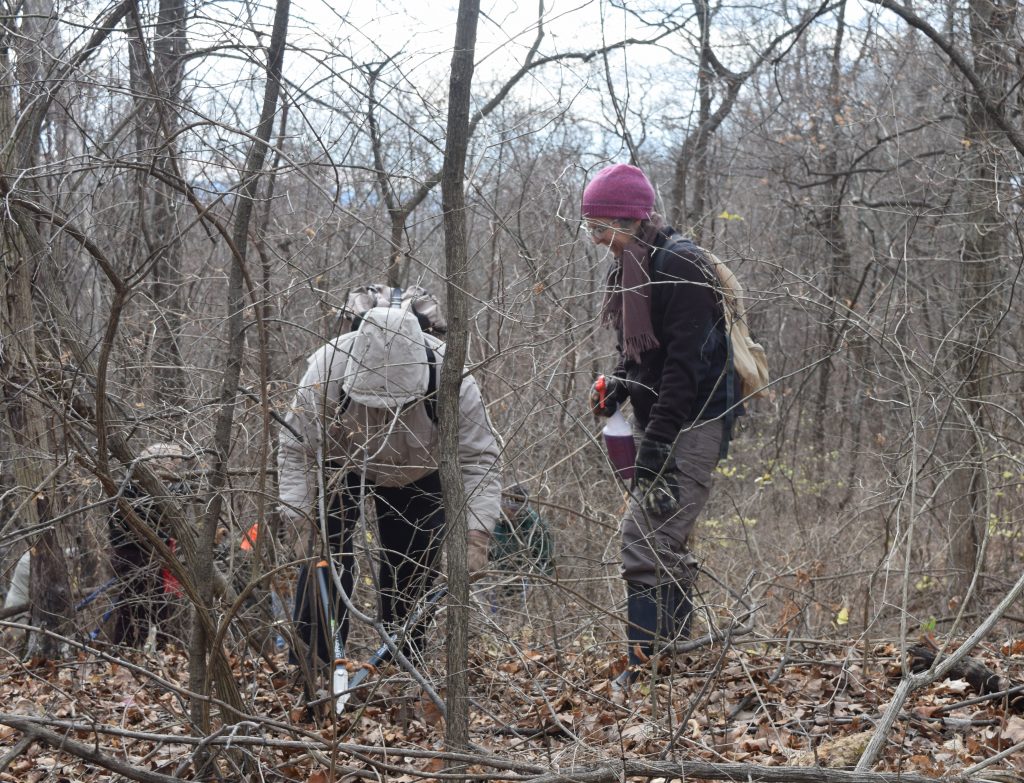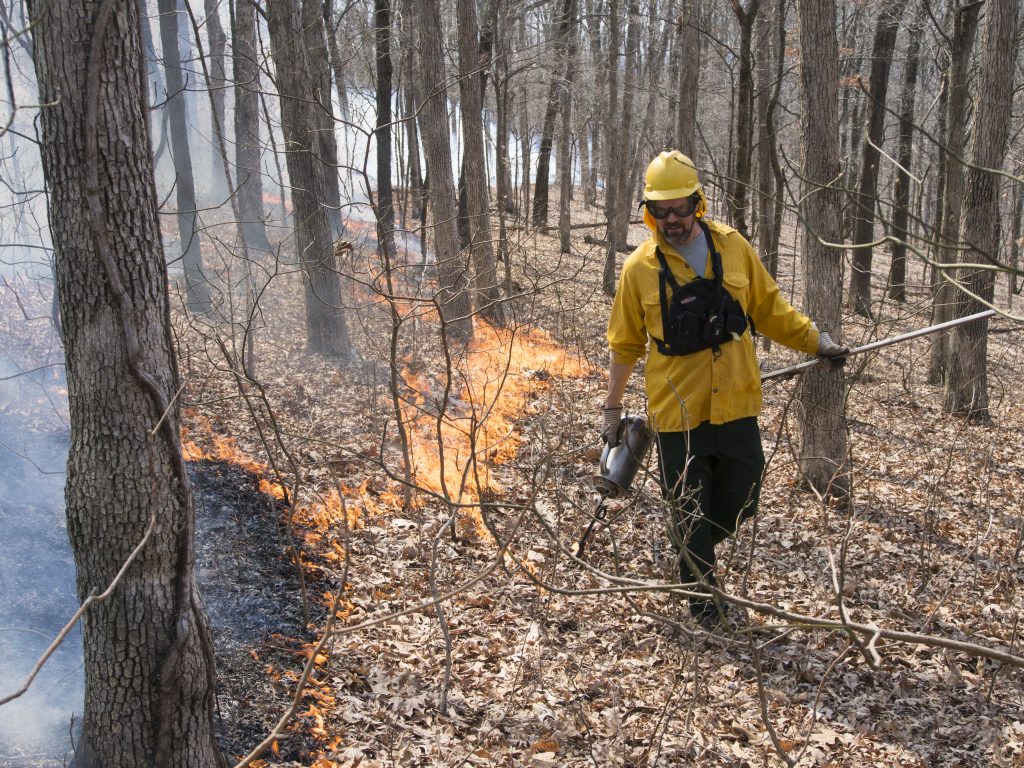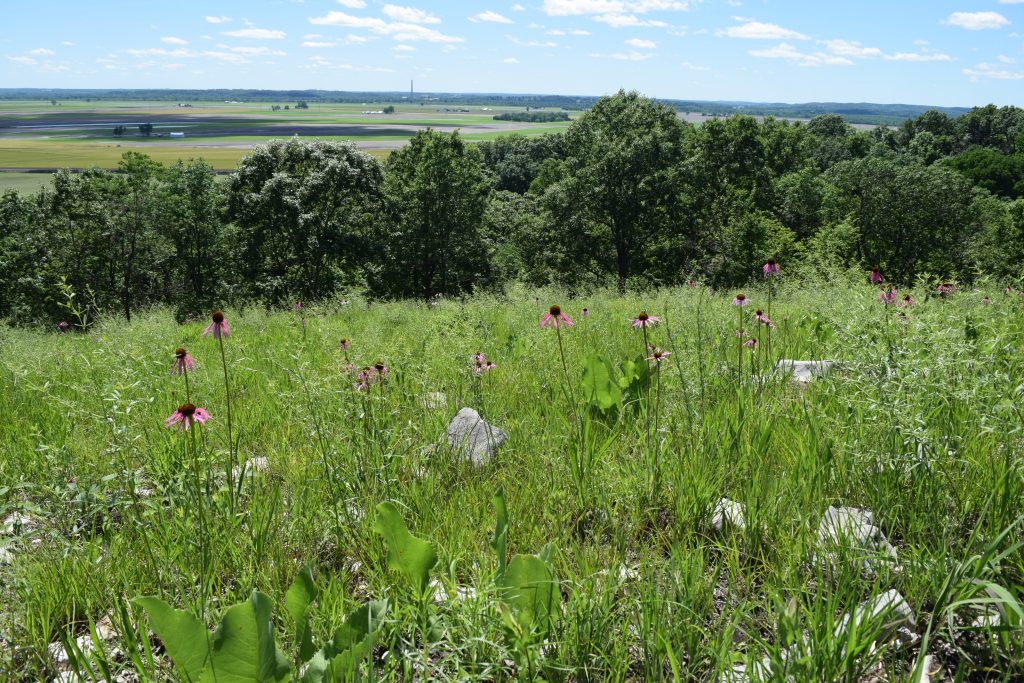How to Protect Land
Last month our CLIFFnotes article was focused on why we protect land. In this column we will discuss the “how” of protecting land.
Protection of land can have two meanings. You can protect the integrity of property by physically eradicating exotic invasive plant species so that native habitats can regenerate and thrive to support native wildlife. Or, you can permanently protect land from development and foreign invasives by dedicating as a Nature Preserve or registering as a Land and Water Reserve through the Illinois Nature Preserves Commission (INPC).
Just as it sounds, physically removing invasive plants is not an easy task, especially if your terrain consists of deep ravines and steep ridges. If you plan to take this on yourself, don’t expect to finish in just a few days. Similar to starting an exercise program, begin slowly and work up to longer stints.

Eradicating Asian bush honeysuckle can be accomplished in various ways—pulling, cutting and treating with herbicide or foliar herbicide spraying. Pulling small bushes can seem easy, but sometimes the taproots break off at the stem. If that happens, treat the portion of the root remaining in the ground as you would a cut stem (we’ll get to that next). For the cut stem/stump treatment method, you will need a pair of loppers, small hand saw, brush cutter or chainsaw to cut through the stem/stump. Immediately treat the stump with a strong herbicide mix (50% glyphosate/50% water is commonly used). Immediacy is key for if allowed to stand more than 15 minutes, the stump will form a scab and the herbicide will not penetrate. After removing large berry bearing bushes, small plants will grow from the seeds left in the ground. These can be eliminated by spraying the foliage with an appropriate herbicide mixed at the recommended rate.
Some invasive plant species can be eliminated using a basal bark treatment. This method is usually used on woody plants that are 6 inches in diameter or less at breast height (DBH). For this, triclopyr mixed with bark oil at the recommended rate can be sprayed directly on the trunk of a tree or bush covering the entire circumference from ground level to 12 or 18 inches upward. Basal bark treatment has been shown to be effective on eliminating Tree-of-Heaven and Russian Olive bushes.

Once large bushes and trees have been removed, repeated prescribed burning is a tremendous tool to keep invasive plants at bay. A prescribed burn can kill small bushes and trees that are not fire tolerant yet will not harm native hardwoods, grasses and forbs. Proper planning is important for a successful burn. Wind direction, humidity levels, air temperature and ground moisture are key elements to take into consideration. Become a Clifftop volunteer to learn more about prescribed burning.
It is evident that protecting your land from invasive plant species by physical removal can be a monumental task for a landowner alone. Another option is hiring a contractor to help. A combination of the two balances physical labor and monetary outlays.
Permanent protection is yet another option.
The Illinois General Assembly established the Illinois Nature Preserves Commission (INPC) in 1963 to create a system of natural areas representative of Illinois’ landscape. The Illinois Natural Areas Preservation Act governs the Commission and charges it to preserve, protect and defend natural areas and endangered species habitat for public benefit.
INPC stewardship programs are designed to help restore and maintain the natural resources found within dedicated Illinois Nature Preserves, registered Land and Water Reserves, enrolled Natural Heritage Landmarks and other natural areas within the state of Illinois for now and the future. INPC staff provides stewardship assistance for protected sites. The INPC actively helps defend protected land to ensure these precious areas are not threatened by improper or illegal use.
The three levels of protection the Illinois Nature Preserves Commission offers are:
Dedication as an Illinois Nature Preserve. Only high-quality natural areas qualify for this land protection tool. Dedication is the strongest protection that can be given to land and provides permanent protection. The owner retains custody but voluntarily restricts future uses of the land in perpetuity to preserve its natural state and to perpetuate natural conditions. Qualifying lands in private, corporate, or government ownership can be dedicated as an Illinois Nature Preserve. This agreement may result in financial benefits to the landowner, primarily in the form of a charitable contribution deduction on federal income taxes and a local property tax reduction. The biggest benefit to the landowner is the assurance that their cherished land will be permanently and legally preserved while still allowing them to enjoy it now and pass it on to their heirs.

Registration as an Illinois Land and Water Reserve. Lands and waters of Illinois that support significant natural heritage or archaeological resources qualify for this land protection tool. The agreement to register an area as a Land and Water Reserve determines allowable uses and stipulates management objectives. Registered Reserves may be in public or private ownership. The agreement may be for a term of years or permanent. The property can be sold or passed on to heirs subject to the agreement. Land and waters permanently registered may qualify for reduced tax benefits in the form of a local property tax reduction and possibly a charitable contribution deduction on federal income taxes.
Enrollment as an Illinois Natural Heritage Landmark. This is a recognition program that introduces a landowner to the concept of natural area protection and allows the state to assist with management of the natural area. It is a voluntary program that increases understanding of the value of natural areas and encourages their preservation by private landowners. An agreement document determines provisions and can be terminated by either party on sixty days notice.
These programs are designed to preserve the natural features of the land and do not require public access to private property.
Whether you choose to protect your land on your own or through the Illinois Nature Preserves Commission, know that future generations will be able to observe and enjoy the plants and animals that have historically inhabited these lands because of your protection.
CLIFFTOP, a local nonprofit organization, is focused on preserving and protecting area bluff lands.
A version of this article appeared in the December 18, 2020 edition of the Monroe County Independent.
©2020 all content rights reserved Clifftop NFP
Comments are currently closed.
